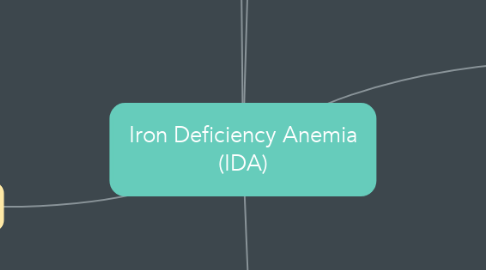Iron Deficiency Anemia (IDA)
by Nichole Zimdars

1. Physical Exam
1.1. EARLY SYMPTOMS Generally non-descript and may include the following; generalized fatigue, weakness, paleness in ear lobes, palms, and conjunctiva, as well as possible shortness of breath (McCance & Huether, 2019). These symptoms should initiate a hemoglobin check. As hemoglobin drops below 7 g/dL symptoms will increase in severity and require further testing (see Labs) (McCance & Huether, 2019).
1.2. IDA PROGRESSION As the condition progresses, many body systems can/will be affected.
1.2.1. GI and oral: Gastritis, burning mouth syndrome, glossitis, pain in the gut and tongue, angular stomatitis (dryness and soreness in the corners of the mouth), difficulty swallowing due to hyposalivation, as well as oral lesions that may have some evidence of leading to cancer (McCance & Huether, 2019).
1.2.2. Respiratory: Increases of shortness of breath, complications with heart failure that will increase length of stay or frequency of hospitalizations (Cappellini et al., 2019).
1.2.3. Skin and nails: Notable defects on nails such as Mees lines, koilonychnia, spooning of nails, brittle and thin nails which are all signs of poor capillary circulation. (Auerbach & Adamson, 2015). Skin becomes progressively pail (McCance & Huether, 2019).
1.2.4. Cardiac/muscular: Fatigue worsens, cardiac murmur, angina, dyspnoea, decreased tolerance for activity, decreased ability to fight congestive heart failure (Cappellini et al., 2019).
1.2.5. Brain: Headaches, vertigo, syncope, restless leg syndrome (Cappellini et al., 2019). Irritability, tingling, neuromuscular changes, gate changes, vasomotor disturbances (McCance & Huether, 2019).
1.2.6. Women and Maternal: Increased hospitalizations and symptoms listed above during menstrual cycles, increased risk of preterm birth, intrauterine growth restriction, low birth weight, increased risk of perinatal complications, increased risk of mortality (Cappellini et al., 2019).
1.2.7. Children: Cognitive delays that may be irreversible (McCance & Huether, 2019). In extreme cases, children are at a higher risk of pica (though adults may experience this as well), particularly with lead paint, chalk, and dirt (Aurbach & Adamson, 2015).
1.2.8. Elderly: On top of findings listed above, mental confusion, increased memory loss, and disorientation independent of normal aging processes (McCance & Huether, 2019).
2. Lab Values
2.1. Labs to follow include: hemoglobin, serum iron, total iron binding capacity (TIBC), serum ferritin, MCV, MCHV, reticulocyte counts, serum transferrin receptor levels, and reticulocyte hemoglobin concentration (Aurbach & Adamson, 2015).
3. Pathophysiology
3.1. Serum iron is used to measure the amount of iron bound to transferrin (a transport protein) which will then become available to hemoglobin in erythroblast development within the bone marrow (Aurbach & Adamson, 2015). The efficiency of recycling of iron by the tissue macrophages from diet and old erythrocytes (Aurbach & Adamson, 2015). Approximately 90% of iron needs for replacement of old red cells comes from the recycling process (Aurbach & Adamson, 2015).. Inflammation can affect this process as the need increases and the ability to recycle decreases (Aurbach & Adamson, 2015).
3.2. Total iron-binding capacity, or TIBC, measures the amount of transferrin circulating (Aurbach & Adamson, 2015). Levels below 20% would indicate that there is not enough iron for the body to properly synthesize hemoglobin (Aurbach & Adamson, 2015). This alone cannot diagnose IDA.
3.3. Serrum Ferritin, or apoferritin, is a protien plasma that indicates iron stores within the body (McCance & Huether, 2019). This will increase may not be entirely accurate as it can increase with inflammation or liver injury (Aurbach & Adamson, 2015). A true low serum ferritin level will only be true in IDA (Aurbach & Adamson, 2015).
3.4. Reticulocyte counts show a percentage of all red cells and can be further broken down to identify the amount of immature cells being released from bone marrow (Aurbach & Adamson, 2015). This can help express the presence of infection and/or blood loss, both of which would require increased iron needs (McCance & Huether, 2019).
3.5. The soluble transferrin receptor (TfR) level will identify the amount of iron intracellularly (Aurbach & Adamson, 2015). Intracellular iron plays a role in regulating iron metabolism (Aurbach & Adamson, 2015). TfR destabalizes TfR mRNA, which blocks the translation of the message (Aurbach & Adamson, 2015). Inflammation does not effect TfR (Aurbach & Adamson, 2015).
3.6. Stage 1: Iron stores are depleted, but erythropoiesis continues as normal (McCance & Huether, 2019).. Stage 2: Transportation of iron in the bone marrow diminishes, therefore erythropoiesis is not iron-deficient (McCance & Huether, 2019).. Stage 3: Cells are now small and hemoglobin deficient as they enter circulation while aged cells are removed where IDA is clinically seen (McCance & Huether, 2019)..
4. Types/Causes
4.1. Most common nutritional disorder - high volume of cow's milk (due to poor bioavailability of iron), junk-food based diets (McCance & Huether, 2019). Impaired absorption - GI disorders, surgical procedures, and fat absorption disorders (McCance & Huether, 2019). Increased requirements - Toddlers, children, and females in reproductive years require higher levels of iron because of growth needs, pregnancy, and menorrhea (McCance & Huether, 2019). Chronic blood loss - may be due to unknown GI bleeds, parasites, diarrhea, and post-surgical bleeds. It is important to check for bleeds if no other cause of IDA can be found (McCance & Huether, 2019).
5. Resources
5.1. Auerbach, M., & Adamson, J. W. (2015). How we diagnose and treat iron deficiency anemia. American Journal of Hematology, 91(1), 31-38. https://doi.org/10.1002/ajh.24201 Cappellini, M. D., Musallam, K. M., & Taher, A. T. (2019). Iron deficiency anemia revisited. Journal of Internal Medicine, 287(2), 153-170. https://doi.org/10.1111/joim.13004 McCance, K. L., & Huether, S. E. (2019). Pathophysiology: The biologic basis for disease in adults and children (8th ed.). Elsevier.

